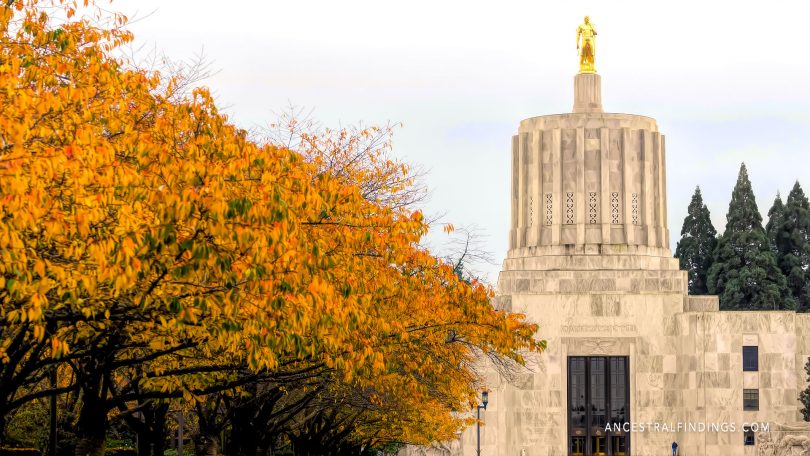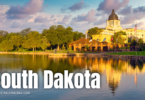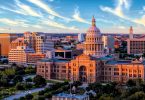The city of Salem is the capital of the state of Oregon. It is also the county seat of Marion County and is located at the center of the Willamette Valley. The Willamette River flows north of Salem and forms a boundary between Marion and Polk Counties in Oregon. It has a population of about 174,000, making it the second-most populous city in Oregon after Portland. It is about an hour away from Portland by automobile. It is also the primary city of the Salem Metropolitan Statistical Area, which includes both Marion and Polk Counties and has about 391,000 people living in it. It is the second-largest such area in the state and is part of the overall Portland-Vancouver-Salem Combined Statistical Area.
Willamette University is located in Salem, as are Corban University and Chemeketa Community College. The State of Oregon is the city's largest public employer, and Salem Health is the largest private one. The city has public busses, Amtrak service, and non-commercial airline service at McNary Field. It is near I-5, as well as Oregon Route 99E and Oregon Route 22.
As with most American cities, the area that is now Salem was occupied by Native Americans for hundreds of years before European explorers came to the place.
The first Native American contact with Europeans in the Salem area occurred at a place the Natives called Chikiti, meaning “meeting place,” or, sometimes “resting place.” The contact was between the Kalapuya Native tribe and Methodist missionaries. The missionaries moved to the area and called their new settlement Chemeketa, after the Kalapuya people's name for the place. Most other European settlers who came to the area after the missionaries called the place the Mill because it was along Mill Creek. The settlement later became known as The Institute, after the Oregon Institute was established there.
After the Institute was disbanded, the trustees of the Institute decided to form a real town there on lands the Institute had owned. Various names for the proposed town were suggested, including Shalom and Jerusalem. The trustees wanted a name for the town with a Biblical meaning. They decided to Anglicize the word Shalom, which means “peace” in Hebrew. This Anglicized name was Salem, which also appeased those who wanted to name the town Jerusalem, as the name used the last five letters of Jerusalem. It was also indirectly named after Salem, Massachusetts, where the Reverend David Leslie, who was the president of the trustees, had completed his education.
The name Salem wasn't a sure thing at first. Many people who lived there wanted to change the name of the town back to Chemeketa. Others preferred calling the town Mill or Mill Creek. The name Salem did eventually stick with the town, and the Vern Miller Civic Center, which is the home of the library and city offices in Salem today, has a public area they call the Peace Plaza that recognizes all of the names by which Salem has been known.
The earliest tribe names are not known, though archaeological evidence of them has been found. The earliest known tribal name there was that of the Kalapuya people. The Kalapuya used to gather on the plateau east and south of town in the winter and stay there in camps to wait out the freeze and snow. While camping there, they would fish in the streams, and later would plant and harvest in the fields there. A staple of the agriculture of the Kalapuya was the camas root. The Kalapuya used to set fires to clear the land and fertilize it for their planting.
The US government removed the Kalapuya and other Native American tribes in the Cascade Mountain area in the early 1850s. This was done by both force and by treaties. The vast majority of the Kalapuya people were moved to the Grande Ronde Reservation to the west of Salem. Other, smaller groups of this tribe went to the Siletz Reservation, and other, lesser known reservations in Oregon and Washington state.
While Spanish explorers had been sailing along the Oregon coast since the early 1500s, none of them ever landed there, though a few shipwrecks happened on the Oregon coast. The artifacts left behind by these shipwrecks were discovered by the Kalapuya and other Native tribes, and they told later European explorers about them. The first Europeans who actually came to the Salem area on purpose were fur trappers who arrived in 1812. They didn't come to stay, though. The first who actually stayed and settled the area were the Methodist missionaries in 1840. The missionaries established the Oregon Institute there in 1842–this was the precursor to Willamette University. The mission dissolved and the town of Salem was established in 1844.
After Oregon became a US territory, its territorial capital was initially at Oregon City. The capital was moved to Salem in 1851. It became incorporated as a city in 1857 and became the state capital when Oregon achieved statehood in 1859.
There have been three capitol buildings in Oregon since it achieved statehood. The first was a two-story house that was only used for two months before it burned down. The second capitol building was finished in 1876 on the site of the original building. It was a Revival-style building that was built to look similarly to the US Capitol Building. A copper dome was placed on it in 1893. This building burned down in April of 1935. The third capitol building in Salem was completed on the site of the first two in 1938. It has a distinctive pioneer statue on top of the dome. The statue is easily recognizable because it is plated in gold leaf and named The Oregon Pioneer.
Salem has an interesting history that goes back into the depths of ancient times, with unknowable people who settled it, fur traders who enjoyed its bounty, missionaries who hoped to convert the Natives, and finally, an establishment as an important and thriving city.





